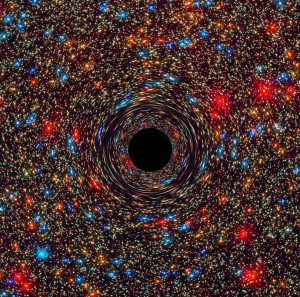Science Seen Physicist and Time One author Colin Gillespie helps you understand your world.
Why Are We Discovering Double Black Holes?
Black holes are in the news again. Only a few weeks ago news of two surprisingly big black holes colliding in a distant galaxy arrived at Earth. Now astronomers have found a closer and far bigger pair of black holes.
First the gravity waves. A fantastically sensitive instrument called LIGO measured them as they rolled by. They delivered multiple messages from co-orbiting black holes falling into each other more than a billion light years away. They gave us direct evidence black holes exist. They showed thirty-solar-mass black holes exist—and may even be common since two of them were orbiting each other. They showed gravity waves exist. And they showed that when black holes collide they behave just as theory predicts.
Conventional wisdom says a black hole begins its career when a big star runs low on fuel and collapses under its own gravity. The collapse (called a supernova) liberates a vast amount of energy. A big star might have a hundred solar masses. But its big supernova blows most of this mass away from the central black hole. This limits its size. Thus thirty-solar-mass black holes were not thought to happen. And here, first black hole that we detect directly is a perfect thirty-solar-mass example. And the gravity-wave signal shows it was in orbit round another of about the same size. This is the first one we find, and we find there are two!
Now the latest news. An international team of astronomers used optical telescopes to look for massive objects. They focused on a galaxy that is a  mere two-hundred-million light years away. They found evidence that at its center there’s a huge black hole.
mere two-hundred-million light years away. They found evidence that at its center there’s a huge black hole.
Of course they can’t see a black hole directly. But they can see the commotion among nearby stars. It told them that the black hole must have the mass of seventeen billion Sun-sized stars.
This is big by any measure but not a record. What makes it special is that it is in a region where the density of matter is sparse. This suggests that huge black holes may be more common than has been supposed.
And there was another message. Stars near the center of the galaxy were neatly organized in a way that a single black hole doesn’t do. It takes two!
Two hundred million years ago the two black holes were orbiting each other. But as they organize the galaxy they lose orbital energy. Maybe they have already merged. If so, the resulting gravity wave is on its way to us. And it will be more than ten-billion-fold more energetic than the one LIGO observed.
Black holes are terrific physics teachers. Huge black holes are assumed to grow by sucking in gas and by merging with others. Some are so far away the light we see has been traveling many billions of years. Astronomers have now seen some that were already huge less than a billion years after the universe began. Conventional wisdom has no way for them to grow so big so soon, starting from inhomogeneity in the hydrogen that filled the early universe.
I suggest there is an alternative explanation for all these black-hole surprises. Trillions of black holes formed in the first instants of the universe as the Planck-scale fabric of space unfolded; we now call them dark matter.
Messages from outer space are teaching us new physics.
Sources:
Jens Thomas et al. (2016), “A 17-billion-solar-mass black hole in a group galaxy with a diffuse core”, Nature, http://www.spacetelescope.org/static/archives/releases/science_papers/heic1607a.pdf
Other Materials:
Robert Sanders (2016), “Supermassive black holes may be lurking everywhere in the universe”, https://news.berkeley.edu/2016/04/06/supermassive-black-holes-may-be-lurking-everywhere-in-the-universe/
Image credit:
NASA, ESA, and D. Coe, J. Anderson, and R. van der Marel (STScI), https://www.nasa.gov/sites/default/files/thumbnails/image/behemoth_blackhole.jpg

No comments yet.